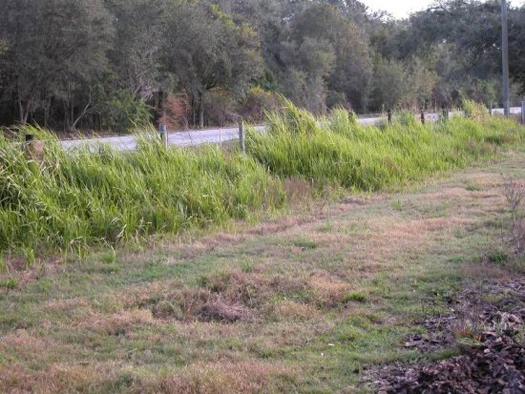Long Term Cogongrass Management in Pastures: Part 3 of a 3 Part Series
Cogongrass is a perennial grass that commonly infests disturbed areas in the Southeast. It invades and persists through several survival strategies including an extensive rhizome system (for underground storage of energy and nutrients), adaptation to a variety of soil conditions, drought tolerance, prolific seed production, and adaptation to fire. Additionally, this weed is unpalatable to livestock because it accumulates silicates along the leaf margin, making leaves hard and razor sharp. Cogongrass also forms a dense mat of cover and quickly displaces desirable forage grasses. Due to these properties, cogongrass is one of the most difficult species to effectively remove from pasture and range settings.
Long term management of cogongrass in pastures entails keeping cogongrass from re-infesting your pasture. Considering that the amount of rhizome biomass that is present in cogongrass infested pastures, total eradication of this plant can be a daunting task. If you follow the detailed steps outlined in the previous issue's Ona Report on cogongrass control, you will be well on your way to cogongrass eradication. But, the question becomes, how do I keep it out? Generally, that is much easier said than done. Before you start managing cogongrass on your ranch, realize that it may take several years and that it will require your commitment to stay after it.
For this article, let's assume that you are well on your way to eradcation of cogongrass in your pasture. To keep cogongrass out, you will need to scout the areas that were previously infested with cogongrass and spray any new shoots that emerge. We suggest scouting in the early spring and fall. Spot-spray these areas with a 3% glyphosate solution as needed to kill these shoots.
In addition to spot-spraying, we are relying on our forage crop to out-compete the cogongrass. Therefore, soil pH and fertility are extremely important. But let's think where most of the cogongrass invasion occurs in our pastures. It tends to be in those pastures where pH is not monitored as closely as it should. Please see EDIS publication "Fertilizing and Liming Forage Crops" to determine the target pH and soil fertility recommendations for your forage crop. Soil pH is one of the most important factors that we overlook and it can have a significant impact on weed management.
Another method to help reduce cogongrass invasion is by not overgrazing your pastures. We realize that this is not always possible, especially during the dry season. However, it is important that the grass forage maintains complete groundcover to limit the potential invasion of cogongrass and to compete with newly emerging shoots.
Essentially, the best offense is a good defense. Our offense for cogongrass management can be considered the use of herbicides for initial control and for maintenance sprays. The defensive strategy comes in with prevention. Preventative strategies include using proper cultural management strategies including soil fertility and grazing management. Also, don't allow yourself to unintentionally spread cogongrass. Make sure that you do not transport seeds or rhizome parts out of cogongrass infested areas. When mowing, clean off the mower deck before leaving the pasture.
In closing these three articles on cogongrass identification, control and management, remember that it is going to take a long-term commitment from all of us to gain good control of this invasive weed. This includes a combined effort from UF-IFAS, landowners and state land managers. As we continue to investigate cogongrass control and its growth parameters, we should be able to improve our management recommendations in the future. If you have any questions regarding cogongrass management in your pasture, please contact your local county extension agent.


